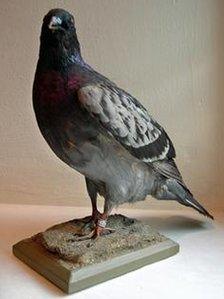The pigeon that saved a World War II bomber crew
- Published

Winkie flew 120 miles across the North Sea back to her home loft
Seventy years ago a carrier pigeon performed the act of "heroism" that saw it awarded the animal's equivalent of the Victoria Cross - the Dickin Medal. It was the first of of dozens of animals honoured by veterinary charity PDSA during World War II.
On 23 February 1942, a badly damaged RAF bomber ditched into the North Sea.
The crew were returning from a mission over Norway, but their Beaufort Bomber had been hit by enemy fire and crashed into the sea more than 100 miles from home.
Struggling in freezing waters - unable to radio an accurate position back to base - the four men faced a cold and lonely death.
But as the aircraft went down, the crew had managed to salvage their secret weapon - a carrier pigeon. The blue chequered hen bird, called Winkie, was set free in the hope it could fly home to its loft in Broughty Ferry, near Dundee, and so alert air base colleagues to their predicament.
During World War II, carrier pigeons were routinely carried by RAF bombers for this very eventuality, though in an era before GPS and satellite locator beacons, rescue was far from certain.
But Winkie did make it home, after flying 120 miles, and was discovered, exhausted and covered in oil by owner George Ross who immediately informed RAF Leuchars in Fife.
The pigeon was not carrying a message, but the RAF were able to calculate the position of the downed aircraft using the time difference between the plane's ditching and the arrival of the bird - taking into account the wind direction and even the impact of the oil on Winkie's feathers to her flight speed.
A rescue mission was launched and the men were found within 15 minutes.
Elaine Pendlebury, from the PDSA, said the carrier pigeon had been released as a "last ditch stand" when the crew realised they had no other options.
"I find it very, very moving really. These people would have died without this pigeon message coming through," said Ms Pendlebury.
Winkie became the toast of the air base, with a dinner held in her honour. A year later, she became the first animal to receive the Dickin Medal - named after PDSA's founder Maria Dickin - for "delivering a message under exceptional difficulties".
More than 60 animals have since received the award, including 18 dogs, three horses and one cat. But pigeons still rule the medal roost, with 32 being given medals, all between 1943 and 1949.
Top secret messages
"It's very hard for us with mobile phones and emails and things like that to think about the way communication would have happened in the 1940s in wartime," Ms Pendlebury told BBC Scotland.
"It was very difficult and the pigeons certainly saved numerous lives by flying through really dreadful situations."
One pigeon, called GI Joe, was an American bird which saved more than 1,000 lives when it got a message through that a village about to be bombed had actually been recaptured by British forces. Another - Mary of Exeter - was used to send top secret messages and received 22 stitches after being injured in the course of her duties.
"I've been a veterinary surgeon for quite some time but I find the ones that have won the PDSA Dickin medal, the stories are quite inspiring - above and beyond really," Ms Pendlebury added.
"The message that's on the medal is 'We Also Serve', which sums it up really."
- Published24 September 2010